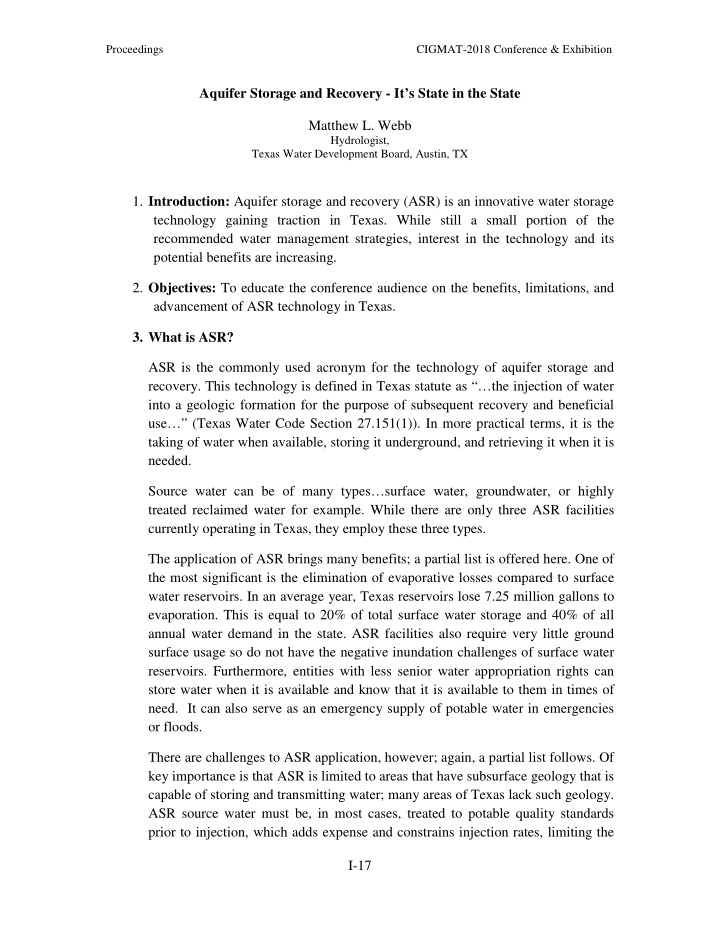



Proceedings CIGMAT-2018 Conference & Exhibition Aquifer Storage and Recovery - It’s State in the State Matthew L. Webb Hydrologist, Texas Water Development Board, Austin, TX 1. Introduction: Aquifer storage and recovery (ASR) is an innovative water storage technology gaining traction in Texas. While still a small portion of the recommended water management strategies, interest in the technology and its potential benefits are increasing. 2. Objectives: To educate the conference audience on the benefits, limitations, and advancement of ASR technology in Texas. 3. What is ASR? ASR is the commonly used acronym for the technology of aquifer storage and recovery. This technology is defined in Texas statute as “…the injection of water into a geologic formation for the purpose of subsequent recovery and beneficial use…” (Texas Water Code Section 27.151(1)). In more practical terms, it is the taking of water when available, storing it underground, and retrieving it when it is needed. Source water can be of many types…surface water, groundwater, or highly treated reclaimed water for example. While there are only three ASR facilities currently operating in Texas, they employ these three types. The application of ASR brings many benefits; a partial list is offered here. One of the most significant is the elimination of evaporative losses compared to surface water reservoirs. In an average year, Texas reservoirs lose 7.25 million gallons to evaporation. This is equal to 20% of total surface water storage and 40% of all annual water demand in the state. ASR facilities also require very little ground surface usage so do not have the negative inundation challenges of surface water reservoirs. Furthermore, entities with less senior water appropriation rights can store water when it is available and know that it is available to them in times of need. It can also serve as an emergency supply of potable water in emergencies or floods. There are challenges to ASR application, however; again, a partial list follows. Of key importance is that ASR is limited to areas that have subsurface geology that is capable of storing and transmitting water; many areas of Texas lack such geology. ASR source water must be, in most cases, treated to potable quality standards prior to injection, which adds expense and constrains injection rates, limiting the I-17
Proceedings CIGMAT-2018 Conference & Exhibition use of ASR to mitigate flood flows. Injecting oxygenated water into the anoxic environments typical of most deep aquifers can also lead to undesirable geochemical reactions. Geochemical sampling and testing should be performed early in any ASR pilot program to assess this risk. Current ASR facilities Texas currently has three operating ASR facilities. El Paso Water Utilities began an ASR project in 1985 with ten wells injected highly treated reclaimed water. They have since moved to increased use of infiltration basins, but still have two functional injection wells. The City of Kerrville has a two-well ASR system (recovery capacity of about 3 million gallons per day) with plans to expand with a third. The system uses treated water from the Guadalupe River to recharge the Lower Trinity Aquifer. The stored water is used to cover peak daily demands during the summer and base demands during low flow conditions on the Guadalupe River. San Antonio has the second largest ASR system in the nation and the most active with over 150,000 acre-feet in storage, 29 wells, and a recovery capacity of 60 million gallons per day. Water is taken from the city’s distribution system, which is primarily sourced from the Edwards Aquifer, and stored in the Carrizo sands of the Carrizo-Wilcox Aquifer. 4. 2017 State Water Plan Texas water planning is based on forecasting from 16 Regional Water Planning Areas, which are consolidated by the TWDB into a State Water Plan every five years. These groups forecast supplies, demands, and needs in decadal increments over a 50-year horizon. They then recommend water management strategies to cover the forecast needs; ASR is one of those strategies. In the 2017 State Water Plan, by decade 2070, ASR is recommended for 152,000 acre-feet of new supply. While still a small contribution at 1.8% of all new 2070 supplies, it is double the percentage noted in the2012 Plan. 5. TWDB funding activities The 84 th Texas Legislature appropriated $1,000,000 to the TWDB for grant funding of innovative water storage approaches. The funding is on a one-for-one matching basis and employed a competitive application process. Applications were taken until November of 2015, and awarded in January of 2016. The TWDB received six applications and awarded three, all for ASR demonstration projects. A summary is shown below. I-18
Proceedings CIGMAT-2018 Conference & Exhibition I-19
Recommend
More recommend